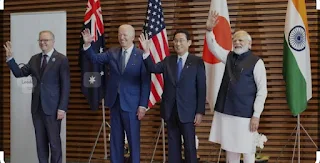<script async src="https://pagead2.googlesyndication.com/pagead/js/adsbygoogle.js?client=ca-pub-6001154395079376"
crossorigin="anonymous"></script>
<script async src="https://fundingchoicesmessages.google.com/i/pub-6001154395079376?ers=1" nonce="VORjmoR0kp6vHx2UH2X8WQ"></script><script nonce="VORjmoR0kp6vHx2UH2X8WQ">(function() {function signalGooglefcPresent() {if (!window.frames['googlefcPresent']) {if (document.body) {const iframe = document.createElement('iframe'); iframe.style = 'width: 0; height: 0; border: none; z-index: -1000; left: -1000px; top: -1000px;'; iframe.style.display = 'none'; iframe.name = 'googlefcPresent'; document.body.appendChild(iframe);} else {setTimeout(signalGooglefcPresent, 0);}}}signalGooglefcPresent();})();</script>

DILAWARE'S QUAD SUMMIT refers to a diplomatic meeting involving four nations viz., United States of America, India, Japan and Australia. This summit is part of the Quad (Quadrilateral Security Dialogue), established to promote cooperation in areas such as security,trade and regional stability in the Indo-Pacific region. These gatherings are typically focussed on enhancing partnerships among the member countries.
One of the topics is reliance on US military weapons by India which has significantly boosted bilateral relations between US and India. This trend reflects India's defence capabilities and enhancing security cooperation with the US, particularly in the context of regional security concerns.
Key points illustrating this relationship include:
1. DEFENCE AGREEMENTS : India has signed several key defence agreements with the US, such as the Communications Compatability and Security Agreement (COMCASA) and the Basic Exchange and Cooperation Agreement (BECA) , facilitating greater military cooperation and intelligence sharing.
2. ARMS PURCHASES : India has increasingly purchased US military equipment, including helicopters, fighter jets, and missile defence systems, which enhances its defence capabilities and inter operability with US forces.
3.JOINT MILITARY EXERCISES : The two nationsconduct various joint military exercises, including the Malabar naval exercises, enhancing the operational coordination and strengthening defence ties.
4. COUNTERING REGIONAL THREATS: The growing partnership is partly driven by shared concerns over regional security threats, particularly from China. Collaboration in the Indo-Pacific region is seen as crucial for maintaining stability.
5. STRATEGIC DIALOGUE: High level dialogues, such as the 2+2 Ministerial Meetings involving foreign and defence ministers from both the countries, aim to enhancestrategic alignment and address common security challenges.
6. INDUSTRIAL COLLABORATION : The US hasencouraged defence manufacturing partnerships in India, promoting initiatives like "Make in India" which aims to boost domestic defence production and technology transfer.
7. LEGISLATIVE SUPPORT : US congress has shown support for enhancing defence cooperation with India through legislation that recognises India as a major defence partner.
8. IMPACT ON GLOBAL POLITICS : Strengyhened US - India ties influence global geopolitics, positioning India as a key player in maintaining a balance of power in the Indo-Pacific region.
This growing military relationship is an essential aspect of athe broader strategic partnership between the US and India, showcasing shared democratic values and mutual interests in promoting peace and stability.



Comments
Post a Comment